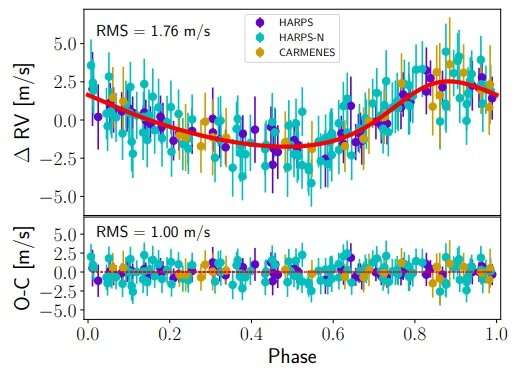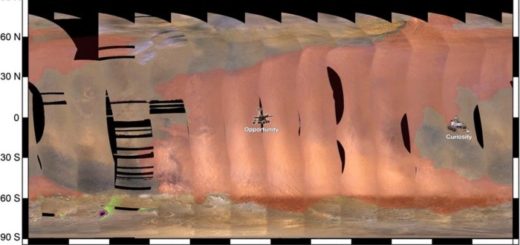Astronomers detect new super-Earth exoplanet orbiting nearby star

Using the radial velocity (RV) technique, astronomers have discovered a new super-Earth alien world as part of the HADES and CARMENES programs. The newfound exoplanet, designated GJ 740 b, orbits a bright star some 36 light-years away and is at least three times more massive than the Earth. The finding is reported in a paper published February 18 on the arXiv pre-print server.
Thanks to the radial velocity (RV) technique, over 600 exoplanets have been detected so far and 116 of them have been found around M dwarfs. The HArps-n red Dwarf Exoplanet Survey (HADES) and Calar Alto high-Resolution search for M dwarfs with Exoearths with Near-infrared and optical Echelle Spectrographs (CARMENES) projects have been crucial in the search for new alien worlds orbiting these most common stars in our galaxy.
Now, a team of astronomers led by Borja Toledo-Padrón of the University of La Laguna, Spain, reports the detection of another exoworld around a nearby M dwarf known as GJ 740. HADES RV program monitored GJ 740 using the HARPS-N spectrograph installed at the 3.6m Telescopio Nazionale Galileo (TNG) in the Roque de los Muchachos Observatory, Spain. Moreover, spectra of this M dwarf were acquired with the CARMENES spectrograph at the Calar Alto Observatory overlapping the epoch during which the HARPS-N observations were carried out.
“Our analysis of the 129 HARPS-N, 57 HARPS, and 32 CARMENES spectra of GJ 740 taken over 11 years shows the presence of a super-Earth orbiting the star,” the researchers wrote in the paper.
The observations found a planet with a mass of at least 2.96 Earth masses, orbiting its host every 2.377 days, at a distance of about 0.029 AU from it, therefore located out of the system’s habitable zone. The equilibrium temperature of GJ 740 b was calculated to be 829 K.
Given that the radius of GJ 740 b is unknown, the composition of this planet is yet to be determined. However, its mass and short orbital period suggest that it is a rocky object.
The host star GJ 740 is a bright high-proper-motion star of spectral type M1V. It has a radius of about 0.56 solar radii and a mass of some 0.58 solar masses. The star’s rotational period was estimated to be approximately 35.56 days, while its effective temperature is at a level of 3,913 K.
The data suggests that the system may host another planet, more massive and at wider separation from the host than GJ 740 b. The astronomers assume that this potential alien world is around 100 times more massive than the Earth and orbits the parent star every 9.3 years.
“The RV time-series exhibits a possibly periodic longterm signal which might be related to a Saturn-mass planet of about 100 Earth masses,” the authors of the paper concluded.



 Creators of mankind
Creators of mankind Description of “Tall white aliens”
Description of “Tall white aliens” Where they came from?
Where they came from? About hostile civilizations
About hostile civilizations The war for the Earth
The war for the Earth “Tall white aliens” about eternal life
“Tall white aliens” about eternal life Video: “Nordic aliens”
Video: “Nordic aliens” Aliens
Aliens Alien encounters
Alien encounters The aliens base
The aliens base UFO
UFO Technology UFO
Technology UFO Underground civilization
Underground civilization Ancient alien artifacts
Ancient alien artifacts Military and UFO
Military and UFO Mysteries and hypotheses
Mysteries and hypotheses Scientific facts
Scientific facts


















